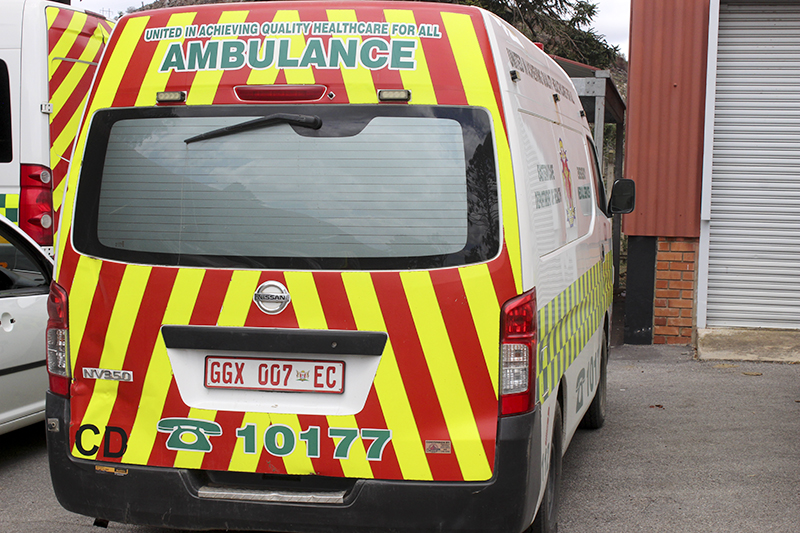Last week, Eastern Cape Premier Oscar Mabuyane, along with MECs for Transport and Health, Weziwe Tikana and Sindiswa Gomba, announced the official handover of 129 new emergency medical services (EMS) vehicles to provincial health facilities, with another 169 expected in the near future. The handover on 8 August was the same day the long-awaited National Health Insurance (NHI) Bill made its Parliamentary debut. Whether Makana will receive any of these vehicles is not yet confirmed.
“In this administration we must talk less and do more,” said Mabuyane during the handover at Bhisho Hospital. “In short, we must get things done. I’m overjoyed that MEC Gomba and Tikana have talked less and done more to deliver on their mandates in a short space of time.”
Mabuyane emphasised that rural districts were going to be prioritised with the new fleet.
Gomba said in her address that currently the province had 447 ambulances, but only 200 were in working condition.
“Most of the citizens [in the rural areas]are elderly pensioners who have challenges of mobility,” said Mabuyane. “The bulk of this fleet is going to provide better healthcare services to them in their communities. This will ensure better response times to our people’s calls for medical assistance.”
Mabuyane called for operating staff of the vehicles to exercise extreme caution and respect for both vehicles and patients. He added that installing cameras into the vehicles was an extreme measure that the province did not yet want to implement as a way to monitor reckless behaviour.
Last year Grocott’s Mail reported extensively on Makana’s EMS crisis, highlighting the severe lack of ambulances in rural areas as well as the drastic waiting times. In 2018, our reporter speculated that Makana had three functional ambulances, servicing a population of over 80 000. According to National Standards implemented by the National Department of Health, one ambulance per 10 000 persons is considered adequate.
However, a 2015 report by the South African Human Rights Commission outlined the dire state of EMS services in the Eastern Cape, stating that as of June 2015 the province had a total of 446 ambulances, not including planned patient transport vehicles (PPTs). This included operational and non-operational vehicles.
| Year | Population | Required number of ambulances per National Standards | Total rostered | Service rate |
| 2015 | 6.56 million | 656 | < 200 | 30% |
| 2019 | 6.60 million | 660 | 249 (with boost) | 37% |
From what our reporter infers, the province is short of 411 working ambulances.
The breakdown of the new vehicles is as follows:
| Total New Vehicles | Ambulances | Patient Transport Vehicles (PTVs) | Response Vehicles |
| 129 | 49 | 40 | 40 |
Provincial Department of Transport Communications Manager, Khuselwa Rantjie, told Grocott’s Mail that R99 323 285.85 was spent on the new vehicles.
“The Eastern Cape Provincial Treasury Through the Department of Transport in 2011/2012 financial year funded the establishment of Government Fleet Management Services Trading Entity (GFMS) with R362 million to procure vehicles from Fleet Africa and other Vehicle Manufacturers,” said Rantjie.
“The GFMS commenced its business in February 2012 and their operating model is focused on leasing vehicles to client departments in the province and retaining funds to be in a position to buy new vehicles on expiry of the lease periods of vehicles. GFMS through its vehicle replacement fund has thus funded these vehicles.”
By the end of September 2018, this entity of the Department of Transport had a net asset value of R1.2 billion.
The vehicles were procured from Nissan, Isuzu and VW South Africa.
Allocation of the new vehicles is as follows:
| District | Total new EMS vehicles |
| Alfred Nzo | 14 |
| Amathole | 10 |
| Buffalo City | 5 |
| Chris Hani | 25 |
| Joe Gqabi | 21 |
| Nelson Mandela Bay | 14 |
| Sarah Baartman | 24 |
| OR Tambo | 16 |
Buffalo City did not receive any new ambulances, while Chris Hani received the most with 12.
Sarah Baartman received seven ambulances, eight PTVS and nine response vehicles. Makana is one of seven municipalities in Sarah Baartman. The Department of Health, as well as Makana Sub-District were approached for comment regarding how many of the new vehicles would be deployed in Makana. The information was not yet known by Makana Sub-District, and the Department of Health did not provide a response.
Mabuyane said the boost was part of the province’s initiative to meet healthcare demands in line with the NHI. Organisations such as Section27 and the SAHRC have fought for improvement in the Eastern Cape’s EMS services for years and the timing of the announcement was significant. So far, NHI pilot projects have taken place in rural areas of the OR Tambo and Alfred Nzo Districts.
Grocott’s Mail will continue to report.


